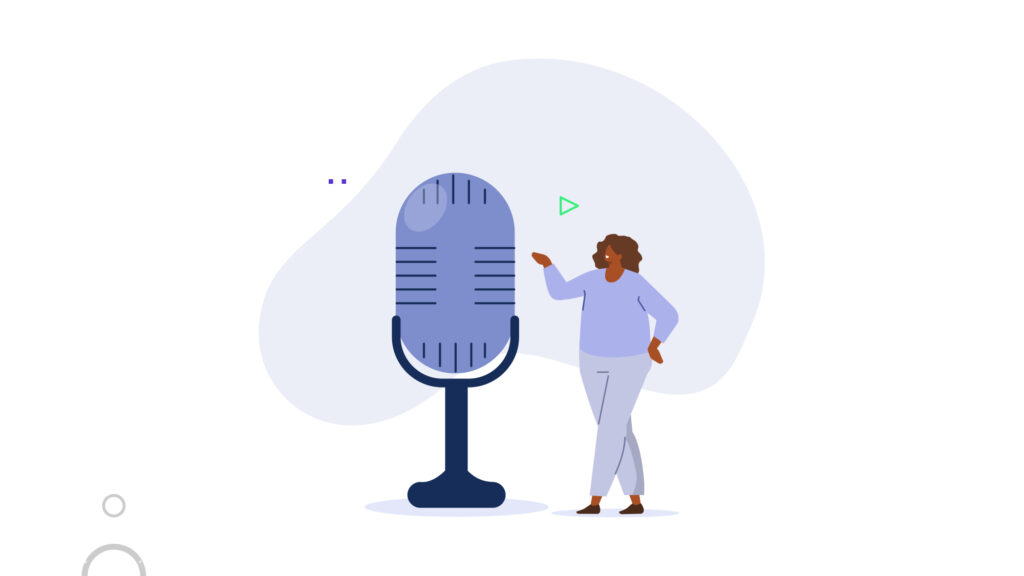Audio by Cameron S. using WellSaid Labs
Ever notice how everyone claims they “have a face for radio”? That cheeky quip hints at the magic of radio: its power to engage and entertain, relying solely on sound.
When we think of radio, we often envision the crisp melodies and articulate voices that emanate from FM stations across America. Yet, there was a time when radio wasn’t the darling of American households. Its journey to prominence was marked by slow acceptance and constant evolution. And today, as it navigates through a maze of competing technologies, its transformation continues, yet its essence remains unshaken.
Dial back to the era between the late 1920s and the early 1950s, and you’ll find yourself in the Golden Age of Radio. This was a time of riveting comedies, heart-tugging dramas, variety shows that showcased a spectrum of talent, game shows that glued families to their sets, and music programs that became the backdrop to countless memories.
Yet, as the 1950s rolled in with the glitz and allure of television, the shimmer of radio’s Golden Age began to wane. However, radio was far from bowing out. Thanks to advancements like stereophonic broadcasting in the 1960s, it not only held its ground but continued to be a major pop-cultural powerhouse.
💡 Learn about WellSaid’s segment on NPR (as the first AI voice on public radio) here
Fast forward to the present day, and the heartbeat of radio endures, albeit with a modern twist. It has embraced new-age technological wonders, like AI voices, paving the way for more diverse and voluminous content than ever before. So, as you tune into the narratives of today, always remember this—never underestimate the timeless poignancy of radio.
As such, today we’re bringing you our editorial’s pick of radio voices! But first, a word on what makes certain radio voices so iconic.
💡Check out our first edition of editorial’s Avatar picks here
The anatomy of iconic radio voices
You might think that a smooth, sultry voice on the radio is just a serendipitous gift from the universe, but the truth is a bit more technical and fascinating. Yes, common sense does dictate that radio performers should be easy on the ears. But science dives deeper, asserting that an ideal radio voice isn’t just about sounding pleasant. It’s about being multiskilled, proficient at reading, and possessing the ability to engage in a conversation that feels genuine and natural with listeners. Moreover, the magic truly happens when a performer’s voice perfectly aligns with the ethos of the station they’re on or the product they’re endorsing.
💡Learn more about the psychology behind voices that resonate
Australian researchers, always eager to decode the mysteries of the human voice, have discovered something rather intriguing. The distinct voices of renowned radio broadcasters might be attributed to their uniquely elastic vocal cords. A recent study revealed that the vocal cords of radio performers close at a quicker rate than those of the average individual. Dr. Cate Madill, a speech pathologist from the University of Sydney, mused, “There is an element of a radio voice that is incredibly distinctive but it’s incredibly difficult to isolate and measure.”
Various studies have tried to pinpoint this elusive quality, describing it using an array of terms like “warm”, “resonant”, “powerful”, “emotive”, and even “authoritative”. Yet, for those venturing into radio, the advice remains timeless. Embrace your authentic voice! And avoid the temptation to rush. Instead, adopt a conversational tone, ensuring clarity and conciseness. This approach makes you sound friendly, approachable, and trustworthy.
Digging a bit deeper into the science of it, our voices come to life when air from our lungs causes the vocal cords to vibrate. This sound then embarks on a journey, passing through the vocal tract, making its primary exit through the mouth and, to a smaller degree, the nose. The vocal tract, with its unique shape and characteristics, interacts with these sounds to create “resonance”. It’s this resonance that bestows our voices with depth, warmth, or even that ringing quality that can set a voice apart.
In the world of radio, where voice reigns supreme, understanding these nuances can be the difference between just-good and unforgettable.
Public vs private radio voices
There’s both an art and science to the voices you hear on the radio. And it seems the type of radio station might play a role in that auditory experience. An intriguing study by ABC Science in Australia dissected the acoustic nuances between radio broadcasters who graced the airwaves of either public or commercial radio stations. The findings? Public broadcasters, as well as non-broadcasters, tended to have voices that resonated with a warmer and deeper tone. In contrast, their counterparts on commercial stations showcased a slightly brighter and perhaps more striking resonant tone.
But, before we journey further, let’s clear up some basics. What separates public radio stations like NPR from commercial ones like KISS FM? The distinctions often lie in their funding models, target audiences, and content objectives, among other factors.
If you’re hankering for real-life examples, let’s take a closer listen:
For the world of public broadcasting, Bob Edwards stands out as an exemplar. Check out this interview below to savor his voice. Edwards’ voice is a masterclass in warmth and depth, characteristics that make his segments engaging and soothing.
On the commercial spectrum, Sue Macgregor shines. You can capture a taste of her voice in this clip. Macgregor’s slightly brighter tonality, typical of commercial broadcasting, exudes energy and vivacity, keeping listeners alert and attentive.
At WellSaid Labs, we recognize the charm and potential of both voice profiles. If you’re aiming for that public radio ambiance with its warmer and deeper resonance, our top Avatar picks are as follows.
Jay S.
Sofia H.
Greg G.
Script: Tune in to WXYZ 91.3 FM for all the latest local news, discussions, and music. Keeping you connected, every step of the way.
Looking for that commercial radio zest with a brighter, perhaps more assertive tone? Then add these voices to your list.
Vanessa N.
Kai M.
Zach E.
Script: Welcome back to Club 808, the exclusive station for our premium listeners only. Dive deep into tailored tracks just for you.
Voices beyond your typical airwaves
When we think of radio, it’s tempting to visualize those energetic morning talk show hosts, discussing the latest in pop culture or perhaps spicing things up with controversial topics. But radio, much like an iceberg, has so much more beneath the surface.
Alongside talk shows, we’re treated to a plethora of ads, unique segments, and even podcasts, which might be pushing the definition of “radio,” but certainly draw from its rich legacy. This rich tapestry of content proves particularly compelling for text-to-speech (TTS) applications, especially when there’s a need to fill in content gaps, localize material, personalize interactions, or simply advertise.
So, let’s take a quick sonic journey and uncover what makes these radio voices truly sing.
Advertisements
Crafting the perfect ad voice-over begins with a fundamental question: Who are you speaking to? Your intended audience will guide your tone, pace, pitch, and even the emotional undertones of your message.
Picture this: promoting a high-end luxury product to an upscale market would naturally lean towards a voice that’s smooth, confident, and dripping with elegance. That’s where a velvety voice like Jude D. can really shine.
Jude D.
Script: Elevate every moment with Elysian Timepieces, where precision meets elegance. Experience luxury that stands the test of time.
On the flip side, an ad for a funky new toy aimed at kids would be best paired with a voice that’s bubbly, energetic, and oozes fun. For a dash of fun and playfulness, Jodi P. should be your go-to.
Jodi P.
Script: Join Buzzy the Bee on his magical garden adventure, now in vibrant color! Spark your child’s imagination, one story at a time.
As a rule of thumb, always envision your voice-over as an intimate conversation with your ideal customer and shape your voice to resonate with their tastes and expectations.
Special segments
Radio doesn’t shy away from mixing things up. We have Q&As, gripping “Story of the Day” segments, audience letter readings, quick recaps, and even live social media reactions. These require a voice that’s well-attuned to the segment’s mood. Yet, since these moments often serve as a breather from the main programming, you’d want a voice that stands out. Look for voices that have a 1) unique character, 2) engaging tonality, and 3) a distinctive sound that serves as a palate cleanser from regular discussions.
Lyric K.
Script: Now on Lively Airwaves, it’s Voices of the City, where we hear heartwarming tales from our very own listeners. Share your story. Let your voice be heard!
Podcasts
The world of podcasts is expansive and ever-growing. Everyone seems to be sharing their voice, from your tech-savvy neighbor to your Great Aunt Gertrude. With so many voices clamoring for attention, how do you stand out? Most podcasting experts advocate for clarity, a touch of naturalness, and a measured pace—hovering around 150-160 words per minute (although that’s terribly specific). And of course, let’s not forget the power of a voice that’s cheerful and bursting with personality. Let Philip J. show you how it’s done.
Philip J.
Script: Welcome to Nebula Narratives! Each episode, we explore the mysteries of our universe. Hit play and journey with us beyond the stars.
Radio and its audio kin offer a world of vocal variety. At WellSaid Labs, we’re passionate about matching the ideal voice to every audio adventure. Whether you’re revving up for an ad campaign, crafting a memorable radio segment, or launching the next big podcast, we’ve got the voice to bring your vision to life.
The resonance of authentic voices on air
It’s evident that while the tools and technology surrounding radio have evolved, the heart of what makes a compelling radio voice remains timeless. Just as we reminisced about the captivating melodies of FM stations and the magic of radio’s Golden Age, the essence of radio has always hinged on the authenticity, warmth, and resonance of the voices that grace the airwaves.
Beyond the technical intricacies, like elastic vocal cords and the nuances of resonance, lies the art of true connection. At its core, a good radio voice goes beyond sounding pleasant to creating a genuine bond with the listener. A bond that feels as real as a conversation over coffee.
Enter the modern age, and we at WellSaid Labs recognize the diverse demands of today’s audio landscape. Radio, with its myriad segments ranging from ads to talk shows, necessitates a kaleidoscope of voices. Whether it’s the smooth allure of a luxury advertisement or the energetic bounce of a youth-centric segment, our repertoire of AI voices is designed to harmonize seamlessly with real voices, ensuring that the essence of radio—the intimacy, the connection, the authenticity—remains intact.
And if you ever find yourself on the crossroads of choice, fret not. Our team of AI voice connoisseurs is always ready to guide you.
In truth, the magic of radio largely hinges on the voices that tell its stories. And in an era where sound is as evocative as sight, it’s the genuine, authentic voices, both human and AI, that leave the most enduring echoes. So, next time you tune in, listen closely, for in the cadence and timbre of those voices, lies the heartbeat of generations. 🎙🧏




